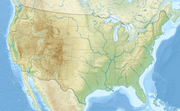Piestewa Peak
| Piestewa Peak | |
|---|---|
| Squaw Peak | |

Brittlebush near the base of Piestewa Peak
|
|
| Highest point | |
| Elevation | 2,610 ft (796 m) NAVD 88 |
| Prominence | 1,176 ft (358 m) |
| Coordinates | 33°32′50″N 112°01′16″W / 33.547332322°N 112.020989392°WCoordinates: 33°32′50″N 112°01′16″W / 33.547332322°N 112.020989392°W |
| Geography | |
| Location | Maricopa County, Arizona, U.S. |
| Parent range | Phoenix Mountains |
| Topo map | USGS Sunnyslope |
| Geology | |
| Age of rock | Precambrian |
| Mountain type | Schist |
| Climbing | |
| Easiest route | Walk up, class 1s3 |
Piestewa Peak (/paɪˈɛstəwɑː/ py-ESS-tə-wah;O'odham: 'Vainom Do'ag', formerly Squaw Peak), at 2,610 feet (796 m) is the second highest point in the Phoenix Mountains, after Camelback Mountain, and the third highest in the city of Phoenix, Arizona. It is located in the Piestewa Peak Recreation Area within the Phoenix Mountain Preserve, near Piestewa Parkway (Arizona State Highway 51). Piestewa Peak is named in honor of Army Spc. Lori Ann Piestewa, the first known Native American woman to die in combat in the U.S. military, and the first female soldier to be killed in action in the 2003 Iraq War.
Since at least 1910, the name Squaw Peak had been used in reference to the mountain. Other historic names included Squaw Tit Mountain, Phoenix Mountain and Vainom Do'ag, the Pima name for the mountain. As the term "squaw" is considered derogatory by some, numerous efforts to change the name of the mountain were made through the years. State Representative Jack Jackson, himself a Navajo, submitted a bill to change the name annually beginning in 1992, which generated repeated and often raw debates in Arizona. In 1997, the local youth group of the American Indian Movement, which filed a petition with the State Board on Geographic and Historic Names in 1997 to change the name to Iron Mountain, the English translation of the mountain's native Pima name. The board researched the issue for nearly a year before ruling in July 1998 that too much doubt existed as to whether the name Vainom Do'ag actually referred to the mountain in question or another nearby peak and the petition was rejected, although the board left the door open to alternative possible name-changes.
...
Wikipedia


